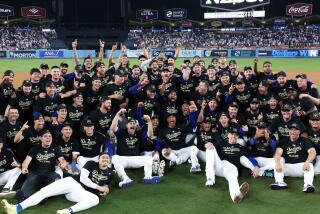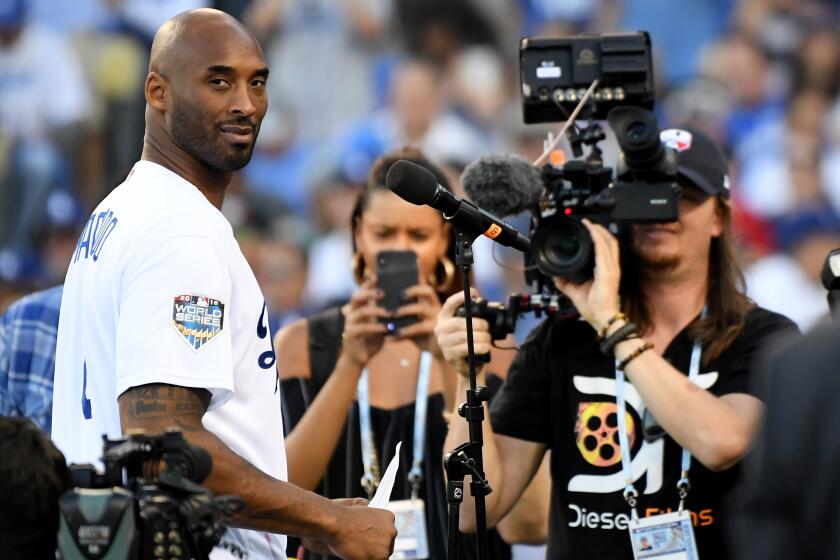FIRM FOOTING : It’s No Accident That Dennis Rasmussen Has Quickly Become a Solid Starting Pitcher for Padres
CINCINNATI — Three weeks, four starts and four victories after joining the San Diego Padres, pitcher Dennis Rasmussen is content with his image.
He’s quiet, careful, walking around the clubhouse like a big pair of Hush Puppies. Sometimes he wears funny little wire-rimmed glasses, the kind that were last seen on the nose of the schoolteacher in “Little House on the Prairie.”
He brags about how he spent last winter, not hunting or fishing or surfing, but changing the diapers of his twin daughters. Wildest thing he ever did was build a radio-operated toy car and run it around stadium infields and over players’ shoes.
Teammates think they know all they need to know about Dennis Rasmussen from this: He grew up in San Clemente and has settled in Omaha. As in Nebraska.
“Usually it works the other way around,” Tim Flannery said, smiling.
All of which is fine with Rasmussen. He is an unusual man in that his favorite impressions are first ones. He welcomes, embraces and nurtures them.
That way, maybe nobody bothers to look any closer. Maybe nobody notices the struggle.
Nobody notices his occasional limp. Nobody notices him swallowing pain killers. Nobody notices that, instead of icing just his left arm after a game, he often ices his left foot as well.
They notice that he never runs sprints with the other pitchers before the games, but rides the stationary bike instead. But they don’t notice that he rarely even walks around outside the team’s hotel with them during the day.
Upon second glance, all you really need to know about Rasmussen is this: His proudest baseball achievement is that he has never missed a big league start because of a foot injury.
On Labor Day, 1973, in the hills behind San Clemente, he virtually lost that left foot. A speeding car, out of control, knocked Rasmussen, then 14, from his bicycle to the pavement and severed all but his Achilles tendon.
The emergency room doctor told Rasmussen’s parents that the dangling remains of the foot would have to be amputated.
But a few minutes later, an orthopedic surgeon, a Vietnam veteran, told the parents that he had seen and fixed worse.
Fifteen years later, with his left leg slightly shorter than his right, Rasmussen has come to the Padres from the Cincinnati Reds as slightly more than a left-handed pitcher. Having made one of the better comebacks in life, he is working on one of the best in-season comebacks in baseball.
He arrived June 8, having been traded for pitcher Candy Sierra. Rasmussen was 2-6 with a 5.75 earned-run average for the Reds. In his final start with Cincinnati, he allowed the Dodgers six runs in 1 innings.
His first start for the Padres was also against the Dodgers. He threw a five-hitter. Eyebrows went up.
Since then, observers have been afraid to blink. He has won all 4 of his starts, 2 of them complete games, has allowed 8 earned runs in 31 innings for a 2.27 ERA, has beaten the first-place Dodgers twice and his old team, the Reds, once.
More than anything else, he has symbolized Manager Jack McKeon’s bottom-line philosophy: It doesn’t matter who you are or where you have been, as long as you win.
And if Rasmussen, a three-year veteran, never wins another big league game, he is a winner.
“Here, I’ll show you,” he said resignedly, pulling off his left sock and revealing a slightly misshapen ankle on which the only other obvious sign of injury is a skin graft.
“You’d be surprised how many people don’t know about it,” he said. “I bet hardly anybody in this clubhouse knows about it. That makes me happy.
“It’s no big deal anymore. I never even think about it anymore. I’ve done too much. I’ve gone too far.”
Quiet, careful Dennis Rasmussen. Do you know why the Reds were willing to trade this former 18-game winner--for the New York Yankees in 1986--who had a record of 45-31, who just last season was 4-1 with a 3.97 ERA in 7 starts?
The Reds considered him timid. Their manager, Pete Rose, didn’t think Rasmussen, who stands 6 feet 7 inches and weighs 225 pounds, throws hard enough--rarely at more than 90 m.p.h.--or mean enough.
“I’ve heard that,” Rasmussen said recently, shaking his head. “I’m never going to show as much emotion as Rose did. If that’s the kind of player he liked, then he probably didn’t like me. I can’t change the way I am. I’m very intense, but I don’t show it, and I know a lot of guys who have made it who don’t show it.
“Whatever they think about me, all I know is, it didn’t keep me from getting to the big leagues.”
What got him there was never thinking about going anywhere else, even when it looked as if he was going nowhere.
When asked how he could so quickly turn around his season, he said: “The way I look at it, I was just throwing badly for Cincinnati and was bound to come out of it sooner or later. Who knows, I could have come out of my slump and done these same things with the Reds. It was just a matter of time.”
Just a matter of time. That’s what he was thinking Sept. 3, 1973, as he lay on the pavement, his legs held up by that frightened driver, his father racing back to San Clemente to phone for an ambulance.
It was just a simple bike ride, a holiday afternoon, father and son, the boy trying to get in shape for his freshman year at San Clemente High, the father trying to keep up.
“Then all of a sudden behind us, over this hill, comes this joy-riding Marine and his girlfriend,” Rasmussen recalled. “They were going over one of those little hills that makes you feel it in the stomach if you go over it too fast. They went over it too fast. We were on the other side of that hill.
“Their car went flying at us. It was a brand-new Jaguar, I’ll never forget that. It came down and hit my right pedal. I went flying.”
The next thing Rasmussen remembers is lying there in the gravel and staring down at his foot. Or what was left of it.
“A stump,” he said. “That’s all I saw, a stump.”
Looking back, he says the most amazing thing was not that he lived or kept the foot, but that he didn’t feel pain or fright.
“I don’t know why. I still don’t know why,” he said. “I remember just looking down there and feeling nothing. It was like, ‘OK, no problem, I know I’m going to be fine.’ ”
Which goes a long way toward explaining how, just six months later, he appeared briefly in each of the last two games of the San Clemente junior varsity basketball team.
“The foot was huge. It was so swollen you couldn’t believe it,” he said. “But I played.”
He endured a month in a hip cast, three weeks in a below-the-knee cast and another month in a soft, movable cast. He tore cartilage and ruptured ligaments, and they needed skin from his hip to make his foot look presentable.
“And I never really thought about it stopping me,” he said. “Never.”
His family moved. He went on to star in three sports at Bear Creek High School in Lakewood, Colo., and he played basketball and baseball at Creighton University in Omaha.
He could do almost everything anyone else could. But he noticed one difference on the basketball court.
“I would run up and down the floor for most of the game,” he said. “But then I couldn’t practice the next day.”
With no padding of cartilage in his foot, bone rubbed against bone. He realized he could never again run for any length of time.
“I run bases, I run to the mound, I break up double plays like everybody else,” he said. “I just can’t go out and run five miles.”
He dealt with this in his early minor league days by riding a stationary bike and doing other exercises. But the closer he came to the big leagues, the greater the pressure for conformity. If you’re a man, you chew tobacco, and if you’re a pitcher, you run.
In 1983, a year in which he led the triple-A International League in wins, 13, and strikeouts, 187, for the Yankees’ Columbus (Ohio) farm club, he came upon a clubhouse in Toledo where there was no bike available. Deciding he was sick of being different, he ran with the other guys, from foul line to foul line, sweating and laughing.
“The next day, I could not walk,” he said. “It was the only time in my career that I’ve had to push back a scheduled start. I didn’t miss it, but I had to push it back two days.”
He has since had to endure the doubts of old-time baseball people who are convinced that he just doesn’t want to run. In a previous stint with the Padres, he could not escape Dick Williams’ stare.
“Williams thought he didn’t want to pitch because he couldn’t run,” said one major league scout. “Thought he didn’t want to run. That’s one of the reasons he wanted his people to get the kid off the team.”
Said Rasmussen: “I know that some people don’t really understand that about me. I know some might not like it. But I work as hard on a bike as I ever could running on pavement. I know what I do, and if they don’t believe me, there’s nothing I can do about it.”
The Padres believe him now. He has returned to a place where he is welcome.
“Run?” McKeon said. “I don’t care about running. We got him to pitch . And so far, that’s what he’s done.”
Said Pat Dobson, the pitching coach: “Results. All we care about are results. Don’t give me how a guy looks on the mound, or whether he throws hard stuff all the time. Give me results. Is the guy a winner? That’s all I care. And so far, Rasmussen has shown us that.”
Trainer Dick Dent has even joked about it. He told Rasmussen upon his arrival that they were going to mail his foot X-rays to the nearest horror show.
“Yeah, it still looks bad. It’s not going to get any better,” Rasmussen said. “But I’m lucky because it’s also not getting any worse.”
And that’s his bottom line.
More to Read
Go beyond the scoreboard
Get the latest on L.A.'s teams in the daily Sports Report newsletter.
You may occasionally receive promotional content from the Los Angeles Times.











